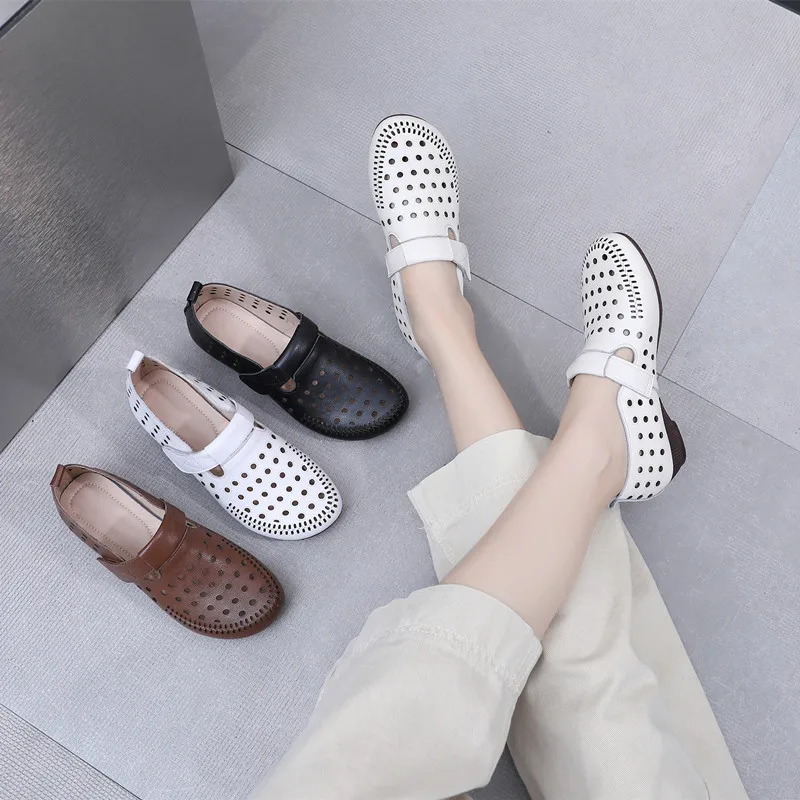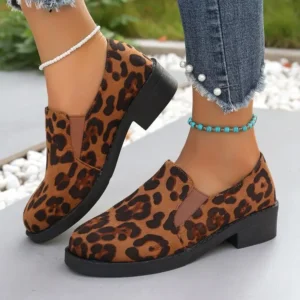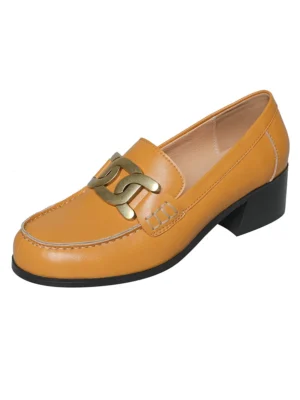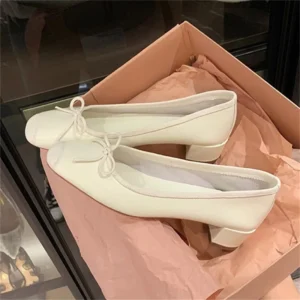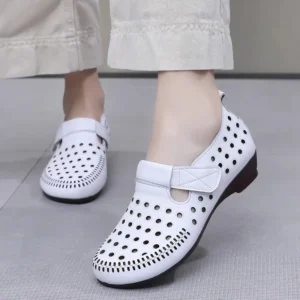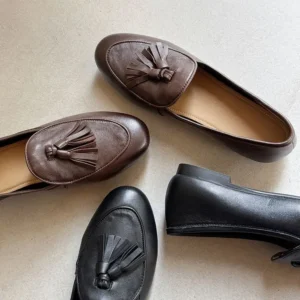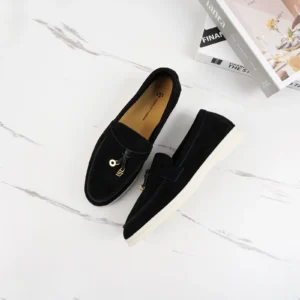Loafers represent the perfect blend of elegance and versatility in footwear. These timeless shoes transition effortlessly from office settings to casual outings, making them a wardrobe essential. However, many people experience discomfort when wearing loafers, leading to blisters, soreness, and frustration.
In this comprehensive guide, we’ll address the common pain points associated with loafers and provide practical solutions to ensure you can enjoy these stylish shoes without suffering. From selecting the perfect pair to breaking them in properly and using essential accessories, you’ll discover how to transform your loafer experience from painful to pleasurable.
Key takeaways you’ll learn:
* How to identify the right loafers for your unique foot shape
* Effective breaking-in techniques that preserve the shoes while increasing comfort
* Essential accessories that prevent pain before it starts
* Troubleshooting solutions for specific pain points
* Long-term care strategies to maintain comfort
With the right approach, you don’t have to choose between style and comfort. Comfortable walking loafers can become your go-to footwear when you understand how to select and wear them properly. Let’s explore how you can enjoy your women’s comfortable flat loafers without sacrificing your foot health.
Why Loafers Can Cause Discomfort: Understanding the Pain Points
Before solving loafer discomfort, it’s important to understand why these shoes can cause pain in the first place. Recognizing the source of discomfort is the first step toward finding effective solutions.
The Break-in Period Challenges
New loafers, especially those made from high-quality leather, often start with significant stiffness. This rigidity means the shoe doesn’t immediately conform to your foot’s unique shape, creating friction points that can lead to blisters and soreness during the initial wearing period.
Fit Issues
Loafers that are too tight compress your feet, causing pressure and restricted blood flow. Conversely, shoes that are too loose create excessive movement, resulting in friction and blisters. Many people also struggle with loafers that don’t match their foot shape—whether too narrow in the toe box, too wide in the heel, or lacking proper arch alignment.
Material Considerations
The materials used in loafer construction significantly impact comfort. Rigid leather can take longer to soften and conform to your feet. Non-breathable synthetic materials trap moisture, increasing friction and the likelihood of blisters. Understanding how different materials behave can help you select loafers that will be more comfortable from the start.
Structural Limitations
Many loafer designs prioritize aesthetics over ergonomics, resulting in minimal cushioning and inadequate arch support. This can lead to fatigue and pain, especially after extended wear. The typically flat construction of many most comfortable loafers for walking all day doesn’t account for the natural contours of human feet.
Common Pressure Points
Friction is the primary culprit behind most loafer-related discomfort. The most common problem areas include:
* Back of the heel, where rubbing can cause painful blisters
* Sides of the feet, especially if the shoes are too narrow
* Tops of the feet, where the vamp (upper part) can create pressure
* Ball of the foot, which lacks cushioning in many loafer designs
Different foot shapes interact differently with various loafer styles. For example, those with wider feet often experience discomfort at the sides, while those with high arches might feel pressure on the top of the foot. Additionally, materials like full-grain leather will eventually stretch and conform to your feet, while many synthetic materials maintain their original shape, potentially causing ongoing discomfort if the initial fit isn’t perfect.
Understanding these pain points helps you make more informed choices when selecting women’s leather flat loafers and implementing comfort-enhancing strategies.
Finding Your Perfect Pair: The Foundation of Comfort
The journey to comfortable loafers begins with selecting the right pair. No amount of inserts, stretching, or breaking-in can fully compensate for loafers that are fundamentally wrong for your feet.
Measuring Your Feet Properly
Start by measuring your feet accurately:
* Measure both feet late in the day when they’re naturally at their largest
* Stand while measuring to ensure weight distribution mimics real-world wearing conditions
* Note both length and width measurements
* Identify your arch type (flat, neutral, or high) as this affects the support you need
Best Practices for Trying On Loafers
When shopping for ideal walking loafers, follow these guidelines:
* Try shoes on in the afternoon or evening when feet are slightly swollen
* Wear the type of socks you plan to wear with the loafers
* Walk around for at least 5-10 minutes in the store
* Check that your longest toe has about a thumb’s width of space from the end
* Ensure the widest part of your foot aligns with the widest part of the shoe
Material Selection for Maximum Comfort
Different materials offer varying levels of comfort:
* Full-grain leather: Initially stiff but molds to your feet over time for a custom fit
* Soft leathers like calfskin: Offer more immediate comfort with less break-in time
* Suede: Typically more flexible and forgiving from the start
* Breathable fabrics: Help prevent moisture buildup and reduce friction
Construction Details That Affect Comfort
Look for these comfort-enhancing features:
* Flexible soles that move with your feet
* Cushioned insoles for shock absorption
* Padded heel collars to prevent rubbing
* Smooth interior stitching to avoid irritation
* Adequate toe box height to prevent pressure on toenails
Width Considerations
Standard width loafers don’t fit everyone. Consider:
* Wide or narrow options if standard widths feel uncomfortable
* How the toe box shape affects comfort (round toe boxes like those in women’s round toe flat loafers typically offer more space)
* The relationship between width and length (sometimes sizing up in length helps with width issues)
Different Loafer Styles and Their Comfort Profiles
- Penny loafers: Classic style with structured shape, may require longer break-in
- Driving moccasins: More flexible construction with nodule soles for immediate comfort
- Tassel loafers: Similar to penny loafers in structure but sometimes with a narrower profile
- Belgian loafers: Often have softer construction and more rounded toe boxes
Signs of Good Fit Versus Poor Fit
A well-fitting loafer should:
* Hold your heel securely without slipping
* Not pinch anywhere around the sides or top
* Allow your toes to wiggle freely
* Feel snug but not tight across the widest part of your foot
* Support your arch properly
Remember that even the most comfortable loafers require some adjustment period, but severe discomfort from the start indicates a poor fit that likely won’t improve with time.
The Perfect Fit: Sizing Strategies for Maximum Comfort
Finding the right size goes beyond simply selecting your usual number. Loafers present unique sizing challenges that require careful consideration.
When to Size Up or Down
Size up if:
* You plan to wear thicker socks
* You have a high instep
* Your feet tend to swell significantly during the day
* The toe box feels constrictingSize down if:
* The loafers slip at the heel
* There’s excessive movement when walking
* The style runs noticeably large
The Importance of Width
Length is just one dimension of proper fit. Width considerations include:
* Recognizing that “D” width in women’s shoes is considered medium
* Understanding that width needs vary throughout the foot (heel, midfoot, forefoot)
* Acknowledging that many foot issues stem from insufficient width, not length
Brand Inconsistency in Sizing
Different manufacturers use different lasts (foot models) to create their shoes:
* European brands often run narrower than American brands
* Some luxury brands size differently from mainstream manufacturers
* Hand-crafted loafers may have more variation than mass-produced styles
This is why it’s helpful to try before buying or check detailed sizing guides when purchasing women’s flat classic loafers online.
Accommodating Foot Conditions
Special considerations for common foot conditions:
* Bunions require wider toe boxes or softer, more flexible materials
* Hammer toes need additional height in the toe box
* Plantar fasciitis requires proper arch support
* Flat feet benefit from supportive insoles
Feet of Different Sizes
Almost everyone has slightly different sized feet. Consider:
* Always fitting to your larger foot
* Using inserts or pads to improve fit on the smaller foot
* Looking for adjustable features like laces or straps when possible
Foot Volume and Loafer Fit
Beyond length and width, the volume of your foot affects fit:
* High-volume feet (thicker from top to bottom) may feel pressure from the vamp
* Low-volume feet may experience slippage even in the correct length and width
* Understanding your foot volume helps in selecting appropriate insert options
| Foot Type | Recommended Sizing Approach | Common Issues to Watch For |
|---|---|---|
| Wide forefoot | Size up or select wide width | Pinching at sides, toe cramping |
| Narrow heel | True to size with heel grips | Heel slippage, blisters |
| High instep | Size up or look for softer uppers | Top-of-foot pressure |
| Low volume | True to size with inserts | Overall looseness, slipping |
| High arches | Focus on support and flexibility | Lack of midfoot contact, fatigue |
| Flat feet | Look for structured support | Overpronation, arch pain |
By understanding these nuances in sizing, you can make more informed decisions and find loafers that truly fit your unique feet.
Breaking In Your Loafers: Gentle Techniques for Lasting Comfort
Even the perfect pair of loafers may require a breaking-in period to achieve maximum comfort. Here’s how to do it safely and effectively.
The Gradual Wear Approach
The safest way to break in loafers:
1. Wear them indoors for 1-2 hours the first day
2. Increase wearing time by 1 hour each subsequent day
3. Monitor for hot spots or areas of discomfort
4. Allow the shoes to rest between wearings (at least 24 hours)
This methodical approach gives both your feet and the loafers time to adjust to each other.
Safe Stretching Methods for Different Materials
Different materials require different approaches:
* Leather loafers: Use leather stretching spray before applying gentle pressure
* Suede loafers: Use specialized suede stretcher spray and wooden shoe trees
* Patent leather: Requires professional stretching as DIY methods may damage the finish
* Canvas or fabric: Can be stretched with moisture and gentle wear
The Thick Socks Technique
This classic method works well for most loafers:
1. Put on the thickest socks that will fit inside your loafers
2. Wear the loafers around the house for 20-30 minutes
3. Use a hairdryer on low heat to gently warm tight spots while wearing
4. Keep the loafers on until they cool completely
5. Repeat as needed until comfortable
Using Shoe Stretchers and Stretching Sprays
For targeted stretching:
1. Apply stretching spray according to product instructions
2. Insert shoe stretcher to desired width or length
3. Turn the stretcher knob until you feel resistance
4. Leave in place for 24-48 hours
5. Use spot stretchers for specific pressure points
Professional Stretching Services
Consider professional help when:
* The loafers are expensive or delicate
* You have significant foot conditions requiring specialized stretching
* DIY methods haven’t provided relief
* The material is difficult to work with (exotic leathers, etc.)
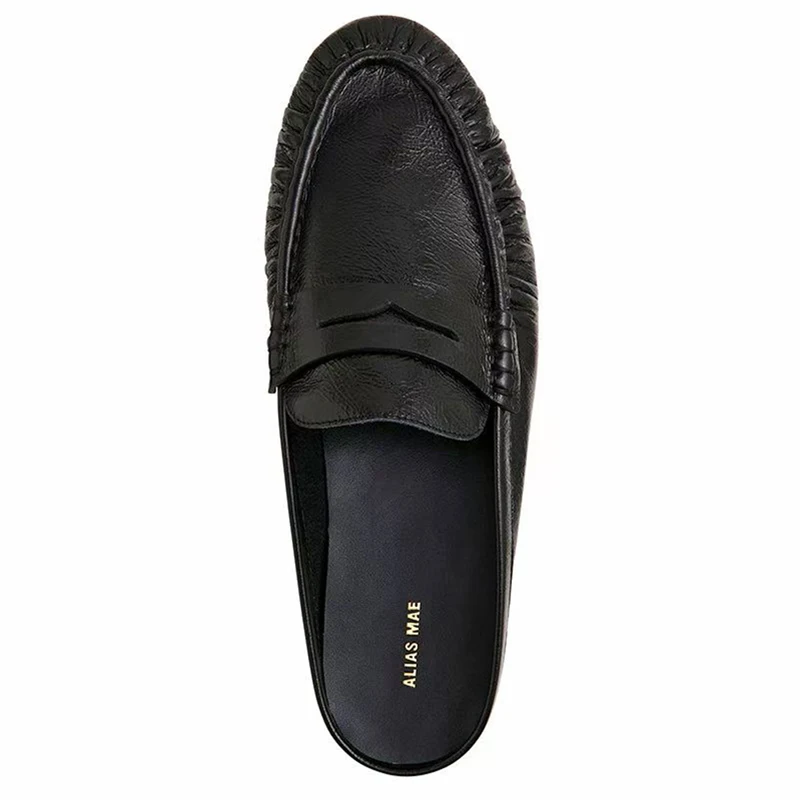
Warning Signs to Watch For
Stop the breaking-in process if you notice:
* Discoloration of the material
* Cracking or damage to seams
* Severe pain beyond minor discomfort
* Blisters or skin irritation
Some penny loafers may never properly conform to your feet if the initial fit is drastically wrong. It’s important to distinguish between normal breaking-in discomfort and signs that the shoes are simply wrong for your feet.
Remember that patience is essential during this process. Quality women’s suede flat loafers will gradually adapt to your feet, but rushing the process can damage both the shoes and your feet.
Essential Accessories: Building Your Comfort Arsenal
The right accessories can transform even challenging loafers into comfortable favorites. Here’s what you need in your comfort toolkit.
No-Show Sock Selection
The foundation of loafer comfort often begins with the right socks:
* Material options:
* Cotton blends: Breathable but may lack staying power
* Bamboo: Moisture-wicking and naturally antibacterial
* Wool blends: Temperature-regulating and odor-resistant
* Synthetic performance fabrics: Excellent moisture management
- Features to look for:
- Silicone heel grips to prevent slipping
- Reinforced heels and toes for durability
- Contoured shape that stays invisible
- Mesh ventilation panels
Many people don’t realize that wearing loafers without socks can actually create more friction and discomfort, despite the popular aesthetic.
Insole and Orthotic Options
Transform the interior comfort of your loafers with:
* Full-length cushioned insoles: Provide overall shock absorption
* 3/4 length insoles: Add cushioning without crowding the toe box
* Arch support inserts: Target specific support needs
* Heel cups: Stabilize the foot and absorb impact
When selecting foot support for flat loafers, consider both the volume of your foot and the available space inside the shoe.
Heel Grips and Liners
Prevent heel slippage and blisters with:
* Adhesive heel liners: Cushion and fill excess space
* Silicone heel grips: Provide friction to prevent movement
* Fabric heel strips: Reduce friction on sensitive skin
Ball-of-Foot Cushions
Relieve pressure on the forefoot using:
* Gel metatarsal pads: Target ball-of-foot pain
* Full-width forefoot cushions: Distribute pressure evenly
* Self-adhesive foam pads: Provide cushioning without shifting
Anti-Blister Products
Prevent painful friction injuries with:
* Blister prevention sticks: Create a friction barrier
* Moleskin: Cut-to-size protection for trouble spots
* Hydrocolloid bandages: Heal existing blisters while preventing new ones
* Silicone toe sleeves: Protect individual toes from rubbing
Moisture Management Products
Control dampness and reduce friction:
* Foot powders: Absorb moisture throughout the day
* Anti-perspirant sprays: Reduce foot sweating
* Moisture-wicking insoles: Keep feet drier longer
Women's Comfortable Flat Loafers, Women's Leopard Print Loafers, Women's Low Heel Loafers
$82.50 Select options This product has multiple variants. The options may be chosen on the product pageWomen's Block Heel Loafers, Women's Heeled Penny Loafers, Women's Monk Strap Loafers
$194.04 Select options This product has multiple variants. The options may be chosen on the product pageWomen's Block Heel Loafers, Women's Square Heel Loafers, Women's Square Toe Flat Loafers
Price range: $73.61 through $86.41 Select options This product has multiple variants. The options may be chosen on the product pageWomen's Comfortable Flat Loafers, Women's Leather Flat Loafers, Women's Round Toe Flat Loafers
$124.88 Select options This product has multiple variants. The options may be chosen on the product pageWomen's Black Flat Loafers, Women's Black Penny Loafers, Women's Classic Tassel Loafers
$194.28 Select options This product has multiple variants. The options may be chosen on the product pageWomen's Loafer Mules, Women's Suede Flat Loafers
$190.23 Select options This product has multiple variants. The options may be chosen on the product page
At Artisan Haul, we believe that comfort shouldn’t be an afterthought. By investing in quality accessories alongside quality loafers, you’ll create a foundation for pain-free, stylish footwear that lasts.
Troubleshooting Guide: Solutions for Common Loafer Pain Points
Even with careful selection and proper breaking-in, you might encounter specific comfort challenges. Here’s how to address the most common issues.
Heel Blisters and Slippage
Problem: The back of the loafer rubs against your heel, causing painful friction.
Solutions:
* Apply moleskin or heel protectors directly to the problem area
* Insert heel grips or cushions to improve fit
* Use double-sided fashion tape to secure the heel temporarily
* Ensure proper sizing—heel slippage often indicates shoes that are too large
Top of Foot Pressure and Pain
Problem: The vamp (upper part) of the loafer creates uncomfortable pressure on the top of your foot.
Solutions:
* Look for loafer styles with softer or more flexible vamps
* Use a shoe stretcher with a vamp attachment
* Apply leather conditioner to soften the material
* Consider styles with elastic goring that offer more flexibility
Toe Box Crowding and Pinching
Problem: Your toes feel cramped, pinched, or develop corns.
Solutions:
* Select round-toe loafer styles that provide more space
* Use a shoe stretcher specifically for the toe box area
* Apply protective silicone toe caps to problem toes
* Consider sizing up or selecting a wider width
Arch Pain and Fatigue
Problem: Your arches ache after wearing loafers, especially after standing or walking for extended periods.
Solutions:
* Add supportive insoles with proper arch contours
* Select loafers with built-in arch support when possible
* Implement foot-strengthening exercises to build arch resilience
* Take periodic breaks to allow your feet to rest when wearing flat loafers
Side-of-Foot Rubbing
Problem: The sides of the loafers create friction against your feet.
Solutions:
* Use targeted stretching techniques to widen specific areas
* Apply moleskin or gel strips to the interior sides of the shoes
* Consider wider width options if consistently problematic
* Look for softer, more pliable materials like suede for the upper
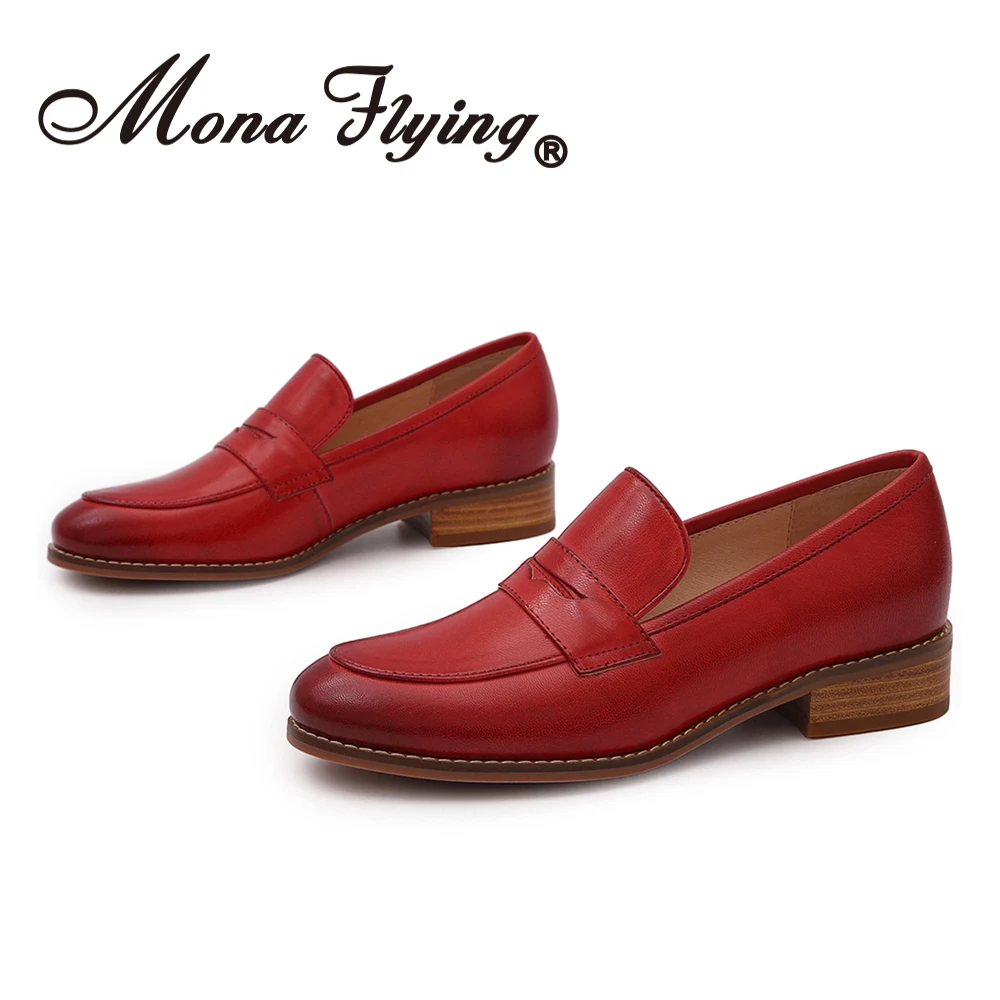
Sweaty Feet Leading to Friction
Problem: Moisture buildup increases friction and discomfort.
Solutions:
* Opt for natural materials that breathe better
* Use moisture-wicking no-show socks
* Apply foot powder before wearing
* Allow loafers to dry completely between wearings
When to Know If a Pair Simply Isn’t Right
Sometimes, despite your best efforts, a pair of loafers simply won’t work for your unique feet. Signs it’s time to move on include:
* Pain that doesn’t improve after 1-2 weeks of proper breaking in
* Persistent blisters in the same locations despite protective measures
* Discomfort that begins immediately upon wearing
* Pain that affects your walking gait or posture
Understanding the secrets of supreme comfort in loafers often means recognizing when a particular style simply isn’t compatible with your foot shape or needs.
Daily Wear Strategies: Maximizing All-Day Comfort
Adopting smart wearing practices can significantly enhance your loafer experience, especially for all-day wear.
Rotating Between Multiple Pairs
One of the most effective strategies for comfortable feet is never wearing the same loafers two days in a row:
* Allow at least 24-48 hours between wearings of the same pair
* This gives materials time to dry completely and regain their shape
* Rotation extends the life of your loafers while reducing foot strain
* Consider alternating between different styles that stress different parts of your feet
Proper Storage Between Wears
How you store your loafers directly impacts their comfort:
* Use cedar shoe trees to absorb moisture and maintain shape
* Allow proper air circulation before storing in closed spaces
* Stuff with acid-free tissue paper if shoe trees aren’t available
* Avoid stacking loafers which can distort their shape
Regular Maintenance to Preserve Softness
Maintenance isn’t just about appearance—it affects comfort:
* Clean regularly to remove dirt and prevent stiffening
* Condition leather loafers every 2-4 weeks to maintain suppleness
* Address scuffs and wear spots promptly to prevent hard edges
* Protect suede with appropriate sprays to maintain its soft feel
Mid-Day Comfort Adjustments
For long days, prepare with strategic comfort adjustments:
* Carry blister bandages for emergency use
* Take short breaks to allow your feet to rest when possible
* Consider a midday sock change if moisture is an issue
* Flex and stretch your feet periodically to improve circulation
Activity-Appropriate Wear
Know when loafers are the right choice:
* Ideal for office settings, casual outings, and light walking
* Consider alternatives for extensive walking or standing
* Choose loafer styles with cushioned soles for busier days
* Select walk-friendly loafers with flexible construction for active days
Weather Considerations
Environmental factors significantly impact loafer comfort:
* Heat and humidity increase foot swelling and moisture
* Cold weather may require thicker socks, affecting fit
* Rainy conditions demand water-resistant materials and treatments
* Consider seasonal rotation of loafer styles and materials
By implementing these daily strategies, you can transform your relationship with your penny loafers from occasional wear to comfortable everyday favorites.
Special Considerations: Solutions for Specific Foot Conditions
Different foot structures and conditions require tailored approaches to loafer comfort.
Flat Feet and Overpronation Adaptations
People with flat feet often experience overpronation (excessive inward rolling). For maximum comfort:
* Select loafers with structured support and firmer soles
* Add orthotic inserts designed specifically for flat feet
* Look for styles with deeper heel cups to stabilize the foot
* Consider loafers with slightly raised arch areas
High Arches and Underpronation Support
High arches can lead to underpronation (insufficient inward rolling) and less natural shock absorption:
* Choose loafers with cushioned insoles and flexible construction
* Add shock-absorbing inserts to compensate for rigid arches
* Select softer leather uppers that conform to the prominent arch
* Avoid completely flat styles without any cushioning
Bunions and Wider Forefoot Accommodations
Bunions require special consideration to avoid painful pressure:
* Select round or square toe boxes rather than pointed designs
* Look for soft, stretchy materials that won’t press on the bunion
* Consider wide width options specifically in the forefoot area
* Use protective gel sleeves or pads over bunions when wearing loafers
Plantar Fasciitis and Heel Pain Management
This common condition requires special attention to heel comfort:
* Choose loafers with cushioned heel areas and arch support
* Add heel cups or specialized plantar fasciitis inserts
* Avoid completely flat loafers without any shock absorption
* Consider slight heel elevation in loafers (½-1 inch) which can reduce tension
Morton’s Neuroma and Forefoot Pressure Relief
This painful condition between the toes requires specific accommodations:
* Select loafers with wider toe boxes to reduce nerve compression
* Add metatarsal pads positioned just behind the ball of the foot
* Choose styles with softer, more flexible soles
* Avoid narrow designs that compress the forefoot
When to Consult a Podiatrist
Consider professional help when:
* Pain persists despite trying multiple comfort solutions
* You have diagnosed foot conditions requiring medical management
* You need custom orthotics designed for your specific needs
* You’re experiencing changes in your gait or balance due to foot pain
Working with foot health professionals can transform your loafer experience, especially when dealing with specific anatomical or medical concerns.
Quick Fixes: Emergency Relief for Unexpected Pain
Sometimes discomfort strikes unexpectedly. Here are rapid solutions for when you’re already out and experiencing pain.
On-the-Go Blister Management
Act quickly at the first sign of friction:
* Apply adhesive bandages or blister-specific bandages directly to hot spots
* Use small pieces of medical or athletic tape over areas that are beginning to rub
* For open blisters, clean the area and apply an appropriate protective covering
* Position bandages to overlap slightly beyond the problem area
Temporary Padding with Available Materials
When proper supplies aren’t available, improvise with:
* Tissues or napkins folded and positioned at pressure points
* Band-Aids wrapped around toes experiencing friction
* Paper towels as temporary insoles to add cushioning
* Clean handkerchiefs or socks positioned to create barriers against rubbing
Adjusting Fit While Wearing
Quick techniques to modify fit on the go:
* Loosen laces or buckles if available on your loafer style
* Remove insoles temporarily if shoes feel too tight
* Adjust sock positioning to add cushioning where needed
* Slightly dampen leather loafers in targeted areas for minimal stretch
When to Remove Shoes and Provide Relief
Know when it’s time for a temporary break:
* At the first sign of significant pain (not just minor discomfort)
* When you notice redness developing on your skin
* If you feel a blister forming
* When your walking gait changes to compensate for pain
Even a five-minute break allowing your feet to rest can prevent more serious issues.
Signs to Stop Wearing Immediately
Some symptoms indicate you should discontinue wear as soon as possible:
* Numbness in any part of the foot
* Sharp, shooting pain rather than general discomfort
* Development of an open blister or skin break
* Significant swelling in localized areas
These emergency strategies can help you manage unexpected discomfort in your low heel loafers until you can address the underlying issues more thoroughly.
Long-Term Loafer Care: Maintaining Comfort Over Time
The longevity of your loafer comfort depends significantly on proper maintenance and care routines.
Cleaning Procedures That Preserve Comfort Features
Regular cleaning not only keeps loafers looking good but also maintains their comfort properties:
* Remove dust and dirt weekly with a soft brush
* Clean leather with appropriate leather cleaner, not harsh soaps
* For suede, use a suede brush and cleaner specifically designed for the material
* Allow shoes to air dry completely away from direct heat
* Clean the interior of loafers with a cloth dampened with diluted vinegar to kill bacteria
Conditioning to Maintain Leather Softness
Keep leather supple to prevent cracks and stiffness:
* Apply quality leather conditioner every 2-4 weeks depending on wear frequency
* Use minimal product and buff thoroughly to avoid over-conditioning
* Pay special attention to areas that flex frequently
* Allow conditioner to absorb completely before wearing
Resoling Considerations for Extended Comfort
Know when and how to replace worn components:
* Replace insoles when cushioning becomes compressed (typically every 6-12 months)
* Consider professional resoling when treads wear down
* Address heel wear promptly as it can affect your walking gait
* Maintain the integrity of the welting (where upper meets sole)
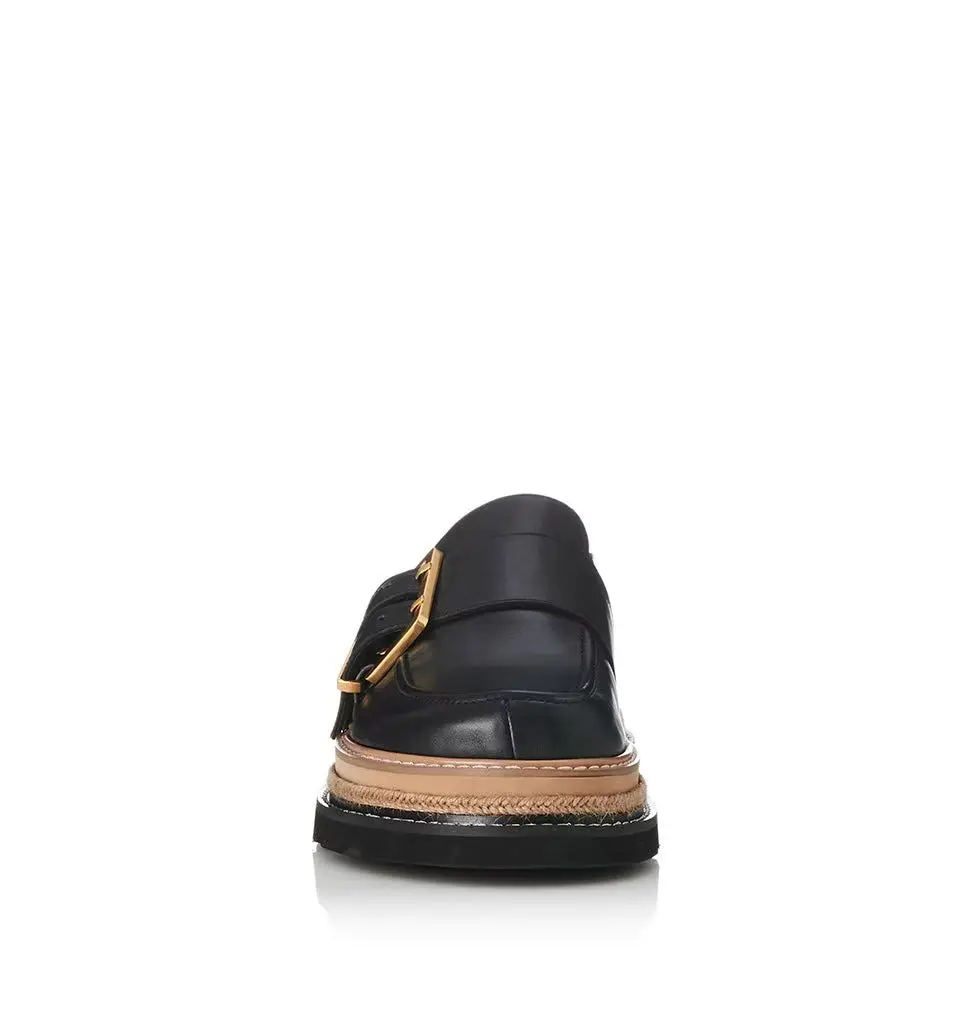
Signs It’s Time to Replace Worn Loafers
Even well-maintained loafers eventually reach the end of their comfortable life:
* Permanent creases that create uncomfortable pressure points
* Interior lining wear that cannot be repaired
* Structural damage to the toe box or heel counter
* Sole wear that affects stability or causes uneven walking
Understanding how to properly care for leather loafers ensures they remain comfortable for years rather than months, making your investment in quality footwear worthwhile.
Extending the Life of Comfort Accessories
Maintain your comfort aids to ensure ongoing effectiveness:
* Wash fabric no-show socks according to instructions to preserve elasticity
* Replace insoles when they lose their cushioning properties
* Clean adhesive heel grips to restore stickiness
* Store gel inserts away from heat to prevent deterioration
With proper care and maintenance, high-quality loafers can provide years of comfortable wear. At Artisan Haul, we believe that investment in proper care is just as important as the initial selection of quality footwear.
By following the comprehensive strategies outlined in this guide, you can transform painful loafer experiences into comfortable, confident steps. Remember that comfort doesn’t mean sacrificing style—it means enhancing your overall experience and enjoyment of these timeless shoes.

